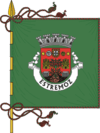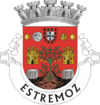Estremoz Municipality
| Estremoz | |||
|---|---|---|---|
| Municipality | |||
| |||
 | |||
| Coordinates: 38°51′N 7°34′W / 38.850°N 7.567°WCoordinates: 38°51′N 7°34′W / 38.850°N 7.567°W | |||
| Country |
| ||
| Region | Alentejo | ||
| Subregion | Alentejo Central | ||
| District/A.R. | Évora | ||
| Government | |||
| • Mayor | Luis Filipe Pereira Mourinha (Ind.) | ||
| Area | |||
| • Total | 513.8 km2 (198.4 sq mi) | ||
| Population | |||
| • Total | 15,064 | ||
| • Density | 29/km2 (80/sq mi) | ||
| Parishes (no.) | 13 | ||
| Municipal holiday |
Ascension Day date varies | ||
| Website | http://www.cm-estremoz.pt | ||
Estremoz (Portuguese pronunciation: [(ɨ)ʃtɾɨˈmoʃ]) is a municipality in Portugal with a total area of 513.82 km² and a total population of 15,673 inhabitants (2001). The city itself has a population of 7,682.[1] It is located in the Alentejo region.
Parishes
- Arcos
- Estremoz (Santa Maria)
- Estremoz (Santo André)
- Évora Monte (Santa Maria)
- Glória
- Santa Vitória do Ameixial
- Santo Estêvão
- São Bento de Ana Loura
- São Bento do Ameixial
- São Bento do Cortiço
- São Domingos de Ana Loura
- São Lourenço de Mamporcão
- Veiros
History
The region around Estremoz has been inhabited since pre-historic times. There are also vestiges of Roman, Visigoth and Muslim occupation.
During the Reconquista, Estremoz was captured in the 12th century by the army of knight Geraldo Sem Pavor (Gerald the Fearless), who had also conquered neighbouring Évora. However, Estremoz was soon retaken by the Moors and only in the mid-13th century reconquered by Portuguese King Sancho II.
King Afonso III granted a letter of feudal rights (foral) to Estremoz in 1258, promoting the colonisation of the area. In the early 14th century, King Dinis I rebuilt the castle as a Royal Palace, turning the village into an important political centre. King Dinis' widow, Queen Isabel, considered a saint by the people, died in Estremoz castle on July 4, 1336. Many later kings and queens lived in Estremoz, like Peter I, who died at the Convent of St Francis in 1367.
During the 1383–1385 Crisis, in which Portugal was almost conquered by neighbouring Castile, Nuno Álvares Pereira established his headquarters in Estremoz, and defeated the Castilian army nearby in the Battle of Atoleiros.
Estremoz was again militarily important in the 17th century, during the Portuguese Restoration War (1640–1668). Forces from Estremoz took part in the decisive Battles of Ameixial (1663) and Montes Claros (1665), once again against the Castilians.
References
- ↑ UMA POPULAÇÃO QUE SE URBANIZA, Uma avaliação recente - Cidades, 2004 Nuno Pires Soares, Instituto Geográfico Português (Geographic Institute of Portugal)
| Wikimedia Commons has media related to Estremoz. |
External links
| |||||

